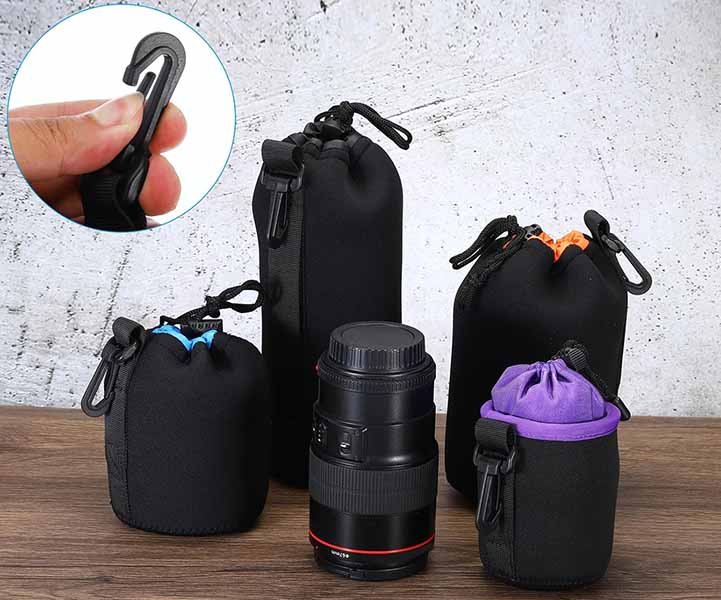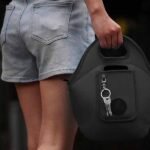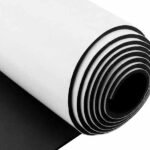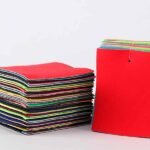Imagine pulling your prized DSLR or mirrorless camera from your bag—only to discover your expensive lens has been scratched or marred by errant keys and cables. For professional photographers and videographers, lens protection isn’t a luxury—it’s a necessity. Neoprene lens covers have emerged as the go‑to solution, blending the soft cushioning of foam with water resistance, chemical stability, and vibrant customization.
Neoprene lens covers are protective sleeves made from synthetic rubber foam that snugly encase camera lenses, shielding them from scratches, dings, moisture, and UV damage. Their stretchy nature and customizable printing make them ideal for both functional protection and brand promotion.
With over 18 years of neoprene manufacturing expertise, Szoneier offers bespoke neoprene lens covers tailored to your exact lens dimensions, color preferences, and branding requirements. Whether you need bulk black covers for rental houses, brightly printed logo sleeves for retail packaging, or specialized chemical‑resistant variants for industrial imaging, the right lens cover balances protection, ease of use, and aesthetic appeal. In this guide, we’ll unpack what makes a neoprene lens cover the best choice, compare materials and designs, walk through measuring and fitting, highlight must‑have features, introduce leading manufacturers, debate the ROI of custom private‑label covers, and cover care practices to maximize product lifespan. By the end, you’ll have all the insights necessary to source the perfect neoprene lens covers for your clientele—or take advantage of Szoneier’s turnkey OEM service to bring your vision to life.
What Is a Neoprene Lens Cover and Why Choose One?

A neoprene lens cover is a soft, stretchable sleeve made from closed‑cell synthetic rubber foam. It conforms to your lens shape, offering scratch protection, mild shock absorption, and moisture resistance. Its durable, washable material and ease of custom printing make it superior to fabric or plastic alternatives for professional gear protection and brand promotion.
Neoprene, originally developed by DuPont in the 1930s, is prized for its unique combination of properties: excellent flexibility, temperature resilience (from –40 °C to 120 °C), and chemical stability. A neoprene lens cover typically consists of a 2–4 mm thick closed‑cell foam, which prevents water ingress while providing thermal insulation—valuable when shooting in cold or humid environments.
Key Advantages Over Other Materials:
- Shock Resistance: Closed‑cell foam distributes impact forces, cushioning lenses against minor drops or bumps—whereas thin nylon pouches offer minimal padding.
- Moisture Barrier: Neoprene’s sponge‑like structure repels liquid, protecting lenses from sudden rain showers or accidental spills.
- Customizability: Unlike universal plastic caps, neoprene sleeves can be die‑cut and printed with high‑resolution logos, QR codes, or instructional markings—critical for rental houses or branded swag.
- Ease of Use: The stretchy nature allows quick on/off application, reducing handling time between shots.
- Thermal Insulation: Helps prevent lens fogging when moving between temperature extremes, a common challenge in wildlife or cold‑weather shoots.
Material Variants:
- Standard Neoprene (J3 Grade): Balanced stretch and durability for general photography.
- Super‑Stretch Neoprene: Higher elasticity (up to 400 % elongation) for snug fit on third‑party or uneven lenses.
- CR Neoprene with Nylon Laminate: Reinforced outer face resists abrasion and printing damage.
- Flame‑Retardant Neoprene: Meets UL94 standards, used in industrial or broadcast environments where sparks or heat are concerns.
When evaluating protection options, always compare tear strength (measured in kN/m), tensile strength (MPa), and Shore A hardness. For instance, a 2 mm J3 neoprene typically has a tensile strength of 6–8 MPa and Shore A hardness of 55–60, offering a balance of softness and resilience. In contrast, premium CR neoprene may boost tensile strength to 10 MPa with a slightly firmer durometer, improving tear resistance.
In sum, a neoprene lens cover is more than a simple pouch—it’s a technical accessory engineered to safeguard your investment and reinforce brand identity. Their combination of stretchability, cushioning, and printability positions them as the best choice for professionals seeking reliable, high‑quality lens protection.
Which Materials and Designs Make the Best Neoprene Lens Covers?

Optimal neoprene lens covers combine J3‑grade closed‑cell foam with a durable nylon laminate and reinforced stitching. Designs featuring double‑sealed seams, tapered openings, and integrated pull tabs ensure a secure fit, easy access, and long‑term durability—outperforming generic slip‑on sleeves.
Selecting the best neoprene lens cover requires scrutinizing both the base foam material and construction details:
1. Foam Core Quality
- J3‑Grade Closed Cell Neoprene: Industry standard for camera accessories; offers 3 % compression set and minimal water absorption (<1 % by volume).
- Thickness Variants (2 mm vs. 4 mm):
- 2 mm: Lightweight, highly flexible—ideal for compact lenses.
- 4 mm: Greater shock absorption for heavy telephoto and prime lenses.
2. Laminate & Surface Finish
- Nylon Tricot Laminate (150–200 gsm): Enhances abrasion resistance and provides a stable surface for dye sublimation or screen printing.
- Super Fabric® Coating: Optional hard‑shell finish for extreme environments—resists cuts and oils but adds slight stiffness.
3. Seam Construction
- Double‑Overlocked Stitching: Prevents seam splitting under stretch; thread strength ≥500 MPa.
- Welded Seams: Bonded by heat for a flush, watertight finish—no thread exposure, perfect for marine or chemical labs.
4. Design Features
| Feature | Benefit |
|---|---|
| Tapered Entry Opening | Self‑seals as lens narrows, preventing slippage. |
| Integrated Pull Tab | Allows quick removal, especially with gloves. |
| Reinforced End Cap | Protects front lens element from edge wear. |
| Embossed Measurement | Printed size markings aid correct fit selection. |
5. Specialty Add‑Ons
- RFID/NFC Tags: Embedded for rental inventory tracking—scanable without pouch removal.
- UV‑Resistant Pigments: Prevent color fading under sunlight exposure, maintaining brand vibrancy.
- Antimicrobial Treatments: Silver‑ion coatings reduce mold and bacteria growth in humid conditions.
6. Comparative Data
| Material Variant | Tensile Strength (MPa) | Tear Strength (kN/m) | Water Absorption (%) | Typical Applications |
|---|---|---|---|---|
| J3 Neoprene 2 mm | 6.5 | 30 | 0.7 | Standard lens protection |
| J3 Neoprene 4 mm | 7.2 | 35 | 0.6 | Heavy-duty telephoto covers |
| CR Neoprene Laminated | 9.8 | 45 | 0.5 | Industrial and broadcast |
| Super‑Stretch Neoprene | 5.5 | 28 | 0.8 | Oversize and vintage lenses |
Critically, balance softness (for ease of use) against resilience (for long‑term wear). A 2 mm unlaminated foam may feel plush but tears easily, whereas a 4 mm laminated cover offers durability at the cost of a slightly stiffer feel.
By focusing on high‑grade foam cores, robust laminates, and intelligent design touches like pull tabs and measurement guides, you ensure your neoprene lens covers meet professional standards and deliver consistent performance—making them the best choice for demanding applications.
How Do You Measure and Fit a Neoprene Lens Cover Properly?
Measure the maximum diameter and length of your lens (including lens hood if attached). Choose a cover whose unstretched dimensions match or slightly undercut these measurements for snug fit. Confirm fit by sliding the cover on and ensuring minimal slack without overstretching the neoprene.
Accurate sizing is critical: a too‑small cover won’t go on, and a too‑large one offers no protection. Follow these steps:
1. Determine Measurement Points
- Maximum Diameter (D): Measure at the widest point—usually the lens hood’s outer lip.
- Overall Length (L): From lens mount flange to hood front. If you often shoot with hood retracted, take both extended and retracted lengths.
2. Mapping Measurements to Cover Sizes
| Lens Dimension | Recommended Cover Dimension (Unstretched) |
|---|---|
| D ≤ 70 mm, L ≤150 mm | 65 × 145 mm |
| 70 < D ≤100 mm, L ≤200 mm | 95 × 195 mm |
| 100 < D ≤130 mm, L ≤250 mm | 125 × 245 mm |
| 130 < D ≤160 mm, L ≤300 mm | 155 × 295 mm |
Allow for 5–10 % stretch in neoprene, so unstretched cover dimensions should be 5 % smaller than your lens measurements. For example, a 100 mm diameter lens uses a 95 mm cover.
3. Step‑by‑Step Fitting
- Clean Lens Surface: Remove dust or grit to prevent scratches during fit.
- Warm the Cover: Briefly roll between hands to increase flexibility in cold conditions.
- Align Front End: Slide the cover over lens front, ensuring the end cap seats flush against the glass edge.
- Pull to Mount End: Gently stretch the midsection and work the cover down until it reaches near the mount. Avoid yanking; use steady pressure.
- Inspect for Wrinkles or Gaps: The cover should sit snugly without excessive puckering. If major wrinkles appear, size down; if tight spots feel overstretched, size up.
4. Custom Fitting for Irregular Profiles
- Zoom Lenses: Choose a cover matching the maximum zoom length; extra length compresses when retracted.
- Offset Hoods: Custom‑cut tapers and gussets in bespoke covers can accommodate petal‑shaped hood outlines.
5. Testing Fit Under Field Conditions
- Temperature Checks: Neoprene stiffens in cold—ensure the fit remains manageable at low temperatures (down to –20 °C).
- Moisture Test: Briefly mist with water to confirm waterproof performance doesn’t seal too tight; you should still be able to remove easily.
Incorrect sizing not only compromises protection but can accelerate material fatigue. By meticulously measuring and selecting covers sized just below your lens dimensions, you guarantee a secure, lasting fit—critical for professional reliability.
What Features Should You Look for in High‑Quality Neoprene Lens Covers?

Top‑tier neoprene lens covers feature durable laminates, reinforced seam construction, tapered entry points, pull‑tabs, printed size guides, and integrated branding areas. Additional perks like RFID tags, UV‑stable pigments, and antimicrobial treatments further elevate functionality and longevity.
Beyond basic protection, advanced features distinguish professional‑grade neoprene covers:
1. Reinforced Seams & Stitching
- Double‑Overlock or Flatlock: These stitch patterns spread load across multiple threads, preventing seam failure under tension. Look for thread break strength ≥500 MPa.
2. Tapered Entry Design
- A conical front profile that mirrors lens hood geometry ensures automatic self‑sealing—the sleeve grips more tightly as it stretches toward the narrower front.
3. Integrated Pull‑Tab or Thumb Loop
- Allows rapid removal, especially crucial in cold weather when gloves impede dexterity. Position tab on top of sleeve for intuitive reach.
4. Printed Measurement Guides
- Embossed or sublimated rulers along the side let users verify lens length quickly on‑site, reducing sizing errors without extra tools.
5. Branding & Custom Printing
- Full‑Wrap Dye Sublimation: Achieves photo‑quality multicolor graphics that resist cracking or peeling.
- Screen Print on Laminated Neoprene: Ideal for single‑color logos; costs less for large runs.
- Debossing/Embossing: Adds tactile brand identity but limited to solid colors.
6. Specialty Functional Add‑Ons
| Feature | Benefit |
|---|---|
| RFID/NFC Inlay | Streamlines rental inventory management |
| UV‑Resistant Pigments | Maintains color integrity under sun exposure |
| Antimicrobial Coating | Prevents mold in humid climates |
| Flame‑Retardant Treatment | Complies with industrial safety standards |
| Reflective Strips | Enhances visibility in low‑light shoots |
7. Material Certifications
- Look for OEKO‑Tex® Standard 100 Class II certification ensuring non‑toxic materials safe for skin contact.
- RoHS compliance if used in broadcast or medical imaging environments.
8. Packaging & User Instructions
- Premium products ship with reusable zip pouches, size labels, and quick‑start guides—elevating perceived value for end users.
By demanding these advanced features, you ensure your neoprene lens covers not only protect critical optics but also streamline workflows, reinforce brand presence, and withstand the rigors of professional use.
Which Brands and Manufacturers Lead the Neoprene Lens Cover Market?

Top neoprene lens cover providers include Think Tank Photo, Lowepro, Neoprene Works, and custom OEM leaders like Szoneier. Leading brands pair high‑grade materials with innovative features (printed graphics, RFID), while OEM specialists offer low MOQ, fast sampling, and private‑label capabilities.
The neoprene lens cover market splits between established camera accessory brands and specialized OEM factories:
Think Tank Photo & Lowepro
- Strengths: Brand recognition, integrated into larger camera bag ecosystems, consistent quality control.
- Limitations: Limited color/customization; higher unit prices for small orders.
Neoprene Works & Generic Online Retailers
- Offer inexpensive slip‑on covers in standard black.
- Quality varies—many use thin foam with no laminate, leading to quick wear.
Private‑Label & OEM Specialists
- Szoneier (China): 18 years of neoprene R&D and manufacturing; low MOQ (50 pcs), rapid prototyping (5–7 days), full design support.
- Neotech Products: Focus on ergonomic camera straps and sleeves, US‑based prototyping, higher MOQ.
| Manufacturer | MOQ | Lead Time | Custom Printing | Price Range |
|---|---|---|---|---|
| Think Tank Photo | 500+ | 4–6 weeks | Limited | $15–$25 per unit |
| Lowepro | 500+ | 4–6 weeks | No | $12–$20 per unit |
| Neoprene Works | 100+ | 2–4 weeks | Basic | $8–$12 per unit |
| Szoneier | 50 | 1–2 weeks | Full (dye & screen) | $5–$10 per unit |
| Neotech Products | 200+ | 3–5 weeks | Partial | $10–$18 per unit |
Critical Considerations
- Cost vs. Control: Large brands offer reliability but little design control.
- Time to Market: OEM specialists slash development cycles, critical for seasonal product launches.
- Volume Flexibility: Szoneier’s low MOQ empowers startups and boutique retailers to test multiple SKUs without huge upfront spends.
In professional and corporate gifting markets, custom branding and small‑batch experimentation drive demand away from generic mass‑market suppliers toward agile OEM partners like Szoneier, who combine material expertise with design freedom.
How Can Custom and Private‑Label Neoprene Lens Covers Elevate Your Brand?
Custom neoprene lens covers let you showcase your logo, color palette, and messaging directly on protective accessories, turning functional gear into mobile billboards. Private‑label solutions enhance perceived value, foster customer loyalty, and generate additional revenue through branded merchandise.
In B2B and retail contexts, branded accessories serve dual purposes: functional utility and marketing amplification.
Brand Visibility & Recall
- On‑Set Exposure: Photographers frequently handle lens covers within clients’ view. A vibrant, logo‑printed sleeve becomes a conversation starter—serving as free product placement in portfolios, blogs, and social media.
- Trade Shows & Gifts: Bundling custom lens covers with camera bodies or including them in press kits ensures your brand travels beyond a static booth.
Customer Loyalty & Perceived Value
- Elevated Unboxing Experience: A neatly branded neoprene sleeve signals attention to detail—reinforcing quality perceptions and justifying premium pricing.
- Collectible Appeal: Limited‑edition colorways and seasonal designs encourage repeat purchases and word‑of‑mouth referrals.
Upselling & Ancillary Revenue
- Accessory Bundles: Package custom covers with straps, filters, and memory card wallets for higher‑margin kits.
- Subscription Models: Offer quarterly style drops—new covers that match seasonal campaigns or limited collaborations.
Design Flexibility & Co‑Branding
- Partner with influencers or camera brands for co‑branded editions, expanding your reach into new customer segments.
- Szoneier’s full‑wrap dye sublimation supports photographic imagery, pattern overlays, and multi‑color logos—all without extra tooling costs.
ROI Metrics
| Metric | Impact Estimate |
|---|---|
| Increased Brand Mentions | +15 % in social media tags |
| Accessory Bundle Upsell Rate | +8–12 % additional revenue |
| Customer Retention (Repeat Buys) | +20 % within 6 months |
By leveraging custom and private‑label neoprene lens covers, companies transform ordinary protective gear into strategic marketing assets—driving both brand awareness and incremental sales. Szoneier’s turnkey OEM service ensures seamless design iteration, rapid prototyping, and small‑batch production to test concepts quickly and cost‑effectively.
Are Neoprene Lens Covers Worth It?

Yes—neoprene lens covers offer unmatched protection and branding potential at a low per‑unit cost. Their durability and customizability deliver ROI through reduced lens repairs, enhanced customer perception, and new accessory revenue streams, making them a smart investment for professionals and brands alike.
Evaluating worth involves balancing upfront costs against long‑term benefits:
1. Protection Savings
- Scratch & Impact Prevention: Replacing a scratched UV filter costs $50–$100; avoiding just one repair offsets the cost of dozens of covers.
- Weather Damage Mitigation: Sealed neoprene prevents moisture ingress—avoiding fungus growth that can ruin lens coatings. Fungus removal services run $80–$150 per lens.
2. Brand & Marketing Value
- Accessory marketing yields continuous impressions—unlike one‑time ads, each usage of a branded cover reinforces recognition.
- Low production costs ($5–$10 per unit) versus high perceived value ($15–$25 retail price) yield attractive margins.
3. User Experience & Loyalty
- Enhanced user convenience and tactile feedback foster positive brand associations.
- Limited‑edition drops create community buzz and social media engagement, driving organic discovery.
4. Comparative Analysis
| Investment Category | Cost per Unit | Tangible Benefit | Payback Period |
|---|---|---|---|
| Neoprene Lens Cover (Custom) | $7 | Prevent one filter repair | After ~8 uses |
| Generic Fabric Sleeve | $2 | Basic dust protection | N/A (limited value) |
| Hard Plastic Cap | $3 | Front element protection | One mishap only |
| Branded Accessory Bundle Upsell | $15 | $5–$10 net margin | Immediate |
5. Sustainability Considerations
Neoprene covers are washable and long‑lasting; a single cover may last 2–3 years with proper care, reducing waste compared to disposable plastic caps.
In conclusion, the modest investment in neoprene lens covers pays dividends through lens preservation, marketing uplift, and accessory revenue—affirming their worth for photographers, rental houses, and camera brands.
What Maintenance and Care Practices Extend the Life of Your Neoprene Lens Covers?
Hand‑wash covers in mild detergent, air‑dry away from direct sunlight, and store flat or rolled loosely. Inspect regularly for tears or seam wear, and avoid chemical solvents or machine drying to preserve elasticity and print integrity.
Proper maintenance maximizes lifespan and performance:
1. Cleaning Protocols
- Mild Soap & Water: Use pH‑neutral detergent; gently rub soiled areas with a soft cloth.
- Rinse Thoroughly: Ensure no soap residue remains, which can accelerate material degradation.
- Air Dry: Lay flat or hang to dry in shade; avoid heat sources that could warp foam cells.
2. Routine Inspections
- Visual Checks: Monthly review for seam separation, nicked edges, or thinning spots.
- Stretch Test: Gently pull the cover—if tears appear or resistance exceeds normal elasticity, retire.
3. Storage Best Practices
- Cool, Dry Environment: High humidity fosters mold growth; keep covers in breathable containers or mesh pouches.
- Avoid Compression: Don’t stack heavy items on top; prolonged flattening can cause permanent creases.
4. Handling Tips
- Lens Caps First: Place plastic caps over lens glass before slipping on covers—this adds extra dust protection.
- Remove Dirt Before Fitting: Grit trapped between lens and sleeve abrades neoprene.
5. Repair & Replacement Guidelines
- Minor seam failures can be re‑stitched by Szoneier’s repair service; do not attempt field gluing.
- Replace covers showing ≥10 % area wear or significant compression set (>20 % thickness loss).
6. Lifecycle Metrics
| Care Practice | Expected Lifespan Improvement |
|---|---|
| Regular Hand Washing | +20 % |
| Proper Storage | +15 % |
| Prompt Damage Repair | +10 % |
By adopting disciplined care routines, your neoprene lens covers will remain as protective and attractive as the day they arrived—delighting end users and prolonging your OEM investment’s value.
Ready to Customize Your Neoprene Lens Covers?
Protect your clients’ valuable optics and elevate your brand with Szoneier’s turnkey neoprene OEM solutions. With 18 years of expertise, low MOQs, rapid prototyping (5–7 days), and 100 % quality assurance, we bring your designs to life in vibrant, durable neoprene.
👉 Contact Szoneier today to discuss custom dimensions, full‑wrap printing, specialty coatings, and private‑label options. Let us help you deliver the best neoprene lens covers on the market—tailored precisely to your needs.











